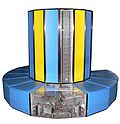Red Storm (computing): Difference between revisions
Added 2008 XT4 upgrade |
Added more facts and figures, with refs |
||
| Line 3: | Line 3: | ||
'''Red Storm''' is a [[supercomputer]] architecture designed for the [[ASCI Thor's Hammer]] supercomputer at [[Sandia National Laboratory]] by [[Cray, Inc]].<ref>[http://www.sandia.gov/ASC/pubs_pres/pubs/RS_flyer.pdf Red Storm fact sheet]</ref> The architecture was later commercially produced as the [[Cray XT3]]. |
'''Red Storm''' is a [[supercomputer]] architecture designed for the [[ASCI Thor's Hammer]] supercomputer at [[Sandia National Laboratory]] by [[Cray, Inc]].<ref>[http://www.sandia.gov/ASC/pubs_pres/pubs/RS_flyer.pdf Red Storm fact sheet]</ref> The architecture was later commercially produced as the [[Cray XT3]]. |
||
It was announced on July 27, 2004.<ref>[http://www.sandia.gov/news-center/news-releases/2004/comp-soft-math/redstormrising.html Sandia Red Storm press release]</ref> |
It was announced on July 27, 2004. The initial configuration comprised 11,648 [[Advanced Micro Devices|AMD]] [[Opteron]] processors, giving a peak performance of 41.5 [[teraflops]].<ref>[http://www.sandia.gov/news-center/news-releases/2004/comp-soft-math/redstormrising.html Sandia Red Storm press release]</ref> |
||
[[Top 500]] performance ranking for Red Storm: |
|||
* November 2005: Rank 6 [http://www.top500.org/system/ranking/7653] |
* November 2005: Rank 6 [http://www.top500.org/system/ranking/7653] |
||
| Line 12: | Line 12: | ||
* June 2007: Rank 3 [http://www.top500.org/system/8193] |
* June 2007: Rank 3 [http://www.top500.org/system/8193] |
||
In 2006 the system was upgraded from 2.0 GHz single-core Opteron processors to 2.4 GHz [[Dual-Core]] Opterons resulting in over 26,000 processor cores. An additional fifth row of computer cabinets were brought online. This resulted in a peak performance of 124.4 teraflops, or 101.4 running the [[Linpack]] [[benchmark]].<ref>[http://www.sandia.gov/news/resources/releases/2006/red-storm.html Red Storm upgrade lifts Sandia supercomputer to 2nd in world, but 1st in scalability, say researchers]</ref> |
|||
A second major upgrade in 2008 introduced [[Cray XT4]] technology: Quad-Core Opteron processors and an increase in memory to 2 GB per core. This resulted in a peak performance of 284 |
A second major upgrade in 2008 introduced [[Cray XT4]] technology: Quad-Core Opteron processors and an increase in memory to 2 GB per core. This resulted in a peak performance of 284 teraflops.<ref>[http://investors.cray.com/phoenix.zhtml?c=98390&p=irol-newsArticle&ID=1104852&highlight=red%20storm Cray and Sandia Announce Agreement to Upgrade "Red Storm" Supercomputer to 284 Teraflops]</ref> |
||
==References== |
|||
==External links and sources== |
|||
<references/> |
<references/> |
||
Revision as of 11:13, 8 December 2008
Red Storm is a supercomputer architecture designed for the ASCI Thor's Hammer supercomputer at Sandia National Laboratory by Cray, Inc.[1] The architecture was later commercially produced as the Cray XT3.
It was announced on July 27, 2004. The initial configuration comprised 11,648 AMD Opteron processors, giving a peak performance of 41.5 teraflops.[2]
Top 500 performance ranking for Red Storm:
In 2006 the system was upgraded from 2.0 GHz single-core Opteron processors to 2.4 GHz Dual-Core Opterons resulting in over 26,000 processor cores. An additional fifth row of computer cabinets were brought online. This resulted in a peak performance of 124.4 teraflops, or 101.4 running the Linpack benchmark.[3]
A second major upgrade in 2008 introduced Cray XT4 technology: Quad-Core Opteron processors and an increase in memory to 2 GB per core. This resulted in a peak performance of 284 teraflops.[4]

